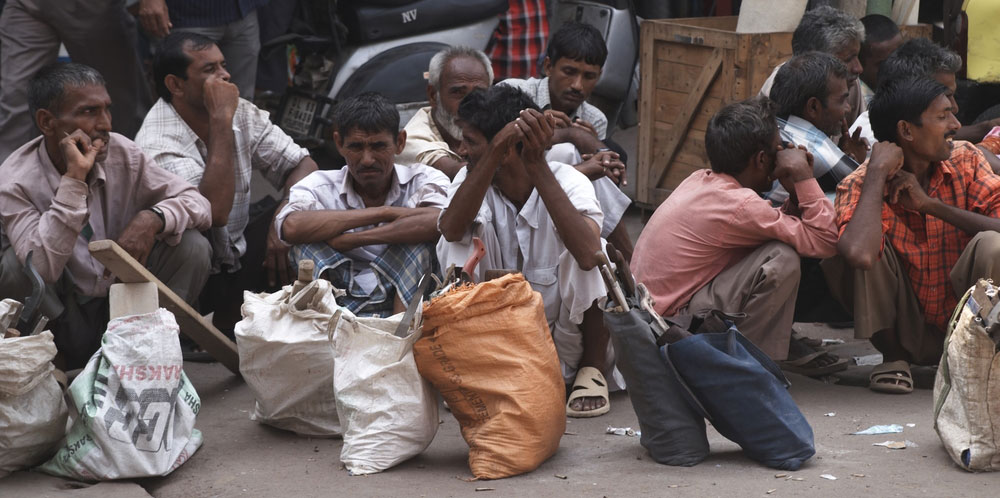A central government agency has been asked to “revalidate” data which estimated that only 1.12 crore additional jobs were created in three years under the Pradhan Mantri Mudra Yojana, a scheme Prime Minister Narendra Modi cites to defend his record on employment generation, sources have told The Telegraph.
Several independent analysts suspect that the Centre is reluctant to release the data without a re-look because the initial estimate does not match its expectations.
As on February 1, nearly 15.73 crore loans had been extended under the scheme, the total amount coming to Rs 7.59 lakh crore.
Against such disbursals, the initial estimate of 1.12 crore additional jobs does fall below expectations, one analyst suggested, adding that many casual workers might have taken the loans without adding any jobs.
Mudra, an acronym for Micro Units Development and Refinance Agency Ltd, is a non-banking finance company that aids the development of micro-enterprises by providing refinance support to banks and micro-finance institutions that lend money to them.
The loans are given to support new as well as existing income-generating activities, thereby helping increase household incomes. The loan amount can go up to Rs 10 lakh but many beneficiaries are said to have taken Rs 50,000 apiece. The Modi government advertises the scheme as a means to raise employment opportunities.
Modi, who has been focusing on national security on the campaign trail, had cited Mudra in an interview with Republic TV last week and suggested that at least 4 crore people had taken money for the first time and “they must have started some employment, they must have employed somebody”.
If the figure of 4 crore new loans is correct and the revalidated data fall below that, it would suggest that some of those who took the loans might already have been employed elsewhere. In any case, when nearly 16 crore loans had been disbursed, the additional job generation should ideally have been more than 1.12 crore.
The release of the official data would have cleared the air on the matter.
The initial estimate of 1.12 crore additional jobs through Mudra was thrown up when the Chandigarh-based Labour Bureau, a government agency, collected data through a nationwide sample survey covering 96,000 respondents.
The Labour Bureau was mandated to survey Mudra beneficiaries to find out the employment generated as a consequence of their entrepreneurial activities. The nine-month fieldwork ended in January.
But last week, an expert committee headed by principal labour and employment adviser B.N. Nanda asked the Labour Bureau to do the revalidation, three official sources have told this newspaper. The panel wanted the revalidation to be carried out “quickly” but did not set a deadline, the sources added.
The expert committee headed by Nanda held its meeting in Shimla, where the Labour Bureau presented the key findings of the survey. The committee did not approve the report’s release, sources said.
The Labour Bureau is now having a re-look at the data. Since the expert committee has not set any deadline, it’s not clear if the report will be ready for publication before the general election.
P.C. Mohanan, who had quit as the acting chairperson of the National Statistical Commission after the government dragged its feet on releasing another set of employment data, told this newspaper that “there is a great reluctance in the government to publish any data that do not match its narrative”.
Santosh Mehrotra, chairperson of the Centre for Informal Sector and Labour Studies at JNU, said he suspected the government expected more favourable figures from the survey. “The government may have expected much more job creation under the Mudra scheme, and was likely disappointed,” Mehrotra said.
On Mudra, the government had filed a written reply in the Rajya Sabha on February 5.
In the reply, junior finance minister S.P. Shukla had said: “An independent study covering PMMY borrowers in 12 states in 2016 has reported that 84 per cent of PMMY borrowers surveyed accepted that loans had helped increase their revenues by 20 per cent to 30 per cent. These loans have helped businesses to add products to their existing offerings and increase inventory to cater to larger set of customers.”
Mohanan said the last economic census had found in 2014 that there were 6 crore enterprises in India. He was curious how nearly 16 crore loans had been extended.
“The number of loans extended appears not to match that of the existing enterprises. Some survey must find out (the reason for the discrepancy). This survey by the Labour Bureau could have given that information,” Mohanan said.
He stressed that timely publication of data was key to transparency.
Mehrotra suspected that many casual workers had taken Mudra loans without adding any jobs.
“Many people doing casual work may have taken loans under Mudra and not added any new jobs… (but merely) switched one kind of precarious work for another. In any case, all Mudra loans were already captured in the 2017-18 PLFS (periodic labour force survey),” Mehrotra said.
The government has recently been accused of hushing up unfavourable job data by virtually sounding the death knell for a Quarterly Employment Survey that tracks eight labour-intensive sectors.
It has also failed to release the report of a “periodic labour force survey”, conducted by the National Sample Survey Organisation, about the job situation in India. Mohanan had resigned from the National Statistical Commission earlier this year in protest against the non-publication of this report.
Nor has the government released the Employment and Unemployment Survey for 2016-17, which the Labour Bureau finalised more than six months ago.
A note from The Telegraph seeking a reaction from the labour ministry had not elicited a response till Wednesday evening.













